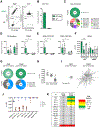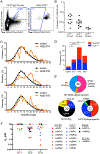A generalized HIV vaccine design strategy for priming of broadly neutralizing antibody responses
- PMID: 31672916
- PMCID: PMC7092357
- DOI: 10.1126/science.aax4380
A generalized HIV vaccine design strategy for priming of broadly neutralizing antibody responses
Abstract
Vaccine induction of broadly neutralizing antibodies (bnAbs) to HIV remains a major challenge. Germline-targeting immunogens hold promise for initiating the induction of certain bnAb classes; yet for most bnAbs, a strong dependence on antibody heavy chain complementarity-determining region 3 (HCDR3) is a major barrier. Exploiting ultradeep human antibody sequencing data, we identified a diverse set of potential antibody precursors for a bnAb with dominant HCDR3 contacts. We then developed HIV envelope trimer-based immunogens that primed responses from rare bnAb-precursor B cells in a mouse model and bound a range of potential bnAb-precursor human naïve B cells in ex vivo screens. Our repertoire-guided germline-targeting approach provides a framework for priming the induction of many HIV bnAbs and could be applied to most HCDR3-dominant antibodies from other pathogens.
Copyright © 2019 The Authors, some rights reserved; exclusive licensee American Association for the Advancement of Science. No claim to original U.S. Government Works.
Figures




Comment in
-
Ushering along B cells to neutralize HIV.Science. 2019 Dec 6;366(6470):1197-1198. doi: 10.1126/science.aaz8647. Science. 2019. PMID: 31806801 No abstract available.
-
bnAbs for HIV: shepherding towards improbable mutations.Nat Rev Immunol. 2020 Feb;20(2):71. doi: 10.1038/s41577-019-0270-0. Nat Rev Immunol. 2020. PMID: 31875058 No abstract available.
-
bnAbs for HIV: shepherding towards improbable mutations.Nat Rev Drug Discov. 2020 Feb;19(2):90. doi: 10.1038/d41573-020-00005-3. Nat Rev Drug Discov. 2020. PMID: 32020072 No abstract available.
References
-
- Fauci AS, An HIV Vaccine Is Essential for Ending the HIV/AIDS Pandemic. JAMA 318, 1535–1536 (2017). - PubMed
Publication types
MeSH terms
Substances
Grants and funding
LinkOut - more resources
Full Text Sources
Other Literature Sources

